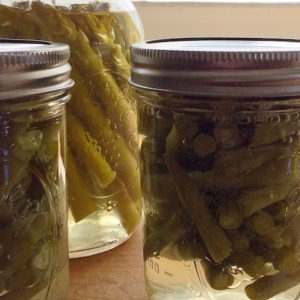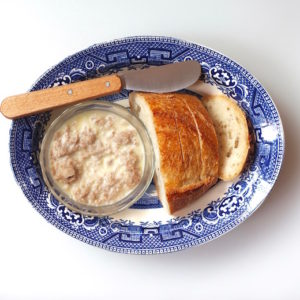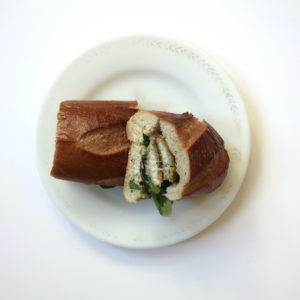Seafood Rillettes
Sometimes a recipe comes to you numerous times before you think to make it.
Such was the case with seafood rillettes. As a nervous fish cook and somebody whose relationship to canned fish began and ended with tuna, seafood rillettes weren’t on my radar.
 Aiming for the casual indoor picnic in Provence thang. Not entirely successful.
Aiming for the casual indoor picnic in Provence thang. Not entirely successful.

Classic rillettes are another story. French cousin to confit, rillettes are chunks of pork or duck, slow cooked in large amounts of pork fat. When tender, the meats are shredded and packed into crocks or jars. The cooking fat is then strained over the meats, and the whole shebang is tucked into a French cellar, or a crummy East Bay kitchen, which is as far from a French cellar as one can get. The rillettes were still wonderful.

Anyway, recipes kept cropping up: in David Tanis’s One Good Dish, in Jean-Pierre Moullé and Denise Lurton Moullé’s French Roots, in Dorie Greenspan’s Around My French Table, and yet again in Everyday Dorie.
These are people who know a lot more than your hostess. And while we can all agree on the wonderfulness that is slow-cooked pork or duck aswim in fat, neither makes one think: summer eating.

As I write, June lurks.
Having consulted the above recipes, I can safely report seafood rillette recipes are flexible things. Some call for a combination of fresh, smoked, and/or canned fish; others use only canned fish. The fats vary, too: instead of pork, think sour cream, creme fraiche, yogurt, butter, and olive oil. Seasonings range from simple salt and pepper to fresh herbs like parsley and chervil. All the recipes I read called for an oniony element, most often chives.
The upshot? Seafood rillettes are more easygoing than their poultry or porcine brethren, cheaper, and much lighter eating.

The IK made her rillettes from cans of tuna and sardines. Canned sardines are a happy new addition to this kitchen: tender, tasty, inexpensive, sustainable, and healthy.
What’s not to like?

Now, canned fish. It is possible to buy terrible canned fish, but hardly necessary. Consider Spain’s DOP appellations, gorgeously designed tins, and painful price tags. Whilst opening your wallet, you might also invest in tuna filets, fetchingly arranged in glass jars. Your hostess looks forward to sampling these items at a later date, when concepts like walking, driving, and shopping resume their rightful places in reality. For now, she stuck close to home (i.e. the Italian deli up the street), and was amply rewarded.

Fish canned in water is ideal for rillettes. I was able to purchase water-canned tuna, but the sardines were packed in sunflower oil, which required draining. While hardly the end of the world, it added a step to an other simple recipe.
Sardines have tiny bones, which you can pick out with your clean fingers, or not. The canning process softens them into edibility, but crunch isn’t really a desirable quality in a rillette. Do the best you can.
On this maiden seafood rillette outing, I used Kerrygold butter as the dominant fat in both recipes.Two teaspoons of yogurt were stirred into the tuna, lending tang without alarming certain yogurt haters, who shall go unmentioned.

Lacking chives, I added the green portion of fresh scallion, parsley, and the merest piece of minced garlic–anything more than mere, and the garlic will take over. Salt, pepper, and lemon juice were mixed in to taste.

Spread your rillettes on on crackers or toasts and call it as an appetizer. Also wonderful, if not very French, is the upscale sandwich created by mounding rillettes into a soft roll with lettuce, tomato, and thinly sliced mild onion. Photos of this sandwich do not exist, as I was far too hungry do anything but eat it. Like we did before social media. We just ate.

Sardine Rillettes
Yield: 8 ounces/1 cup/464grams
Preparation time: The butter must be softened, so remove it from the refrigerator at least an hour before mixing the rillettes. Actual prep is moments. Rillettes are best chilled for at least six hours before consuming.
Note the recipe gives starting amounts for seasoning. You may want or need to add more or less butter–you’re looking for a creamy, spreadable mixture that’s nicely seasoned at cool room temperature.
Ingredients:
One 3-ounce/85-gram tin sardines, ideally packed in water
about one tablespoon/15g unsalted, softened butter, preferably a higher-fat, European-style butter like Kerrygold or Plugra.
1/2 teaspoon salt
1/2 teaspoon pepper
2 teaspoons parsley, finely minced
1 scallion, green portion only, minced
lemon juice, to taste
Drain the sardines in a colander and bone them as best you can. A few bone fragments are fine.
Crumble the fish into a medium bowl and add the butter. Mix using your clean fingers or a spatula. You may need to add butter: you’re looking for a creamy mixture that holds together without crumbling.
Once the butter and fish are amalgamated, stir in remaining ingredients, tasting for seasoning.
Pack rillettes into small crocks, custard cups, or lidded storage containers. If your crocks don’t have lids, cover them tightly with plastic wrap.
Chill 6 hours.
Fifteen minutes before consuming, remove rillettes from refrigerator. Serve on crackers, toasts, or, less conventionally in a sandwich with lettuce, tomato, and onion.
Sardine rillettes will keep, covered and refrigerated, for four days.
Tuna Rillettes
yield: about 12 ounces/1/1/2 cups/350 grams
Prep time: Butter must be soft, so take it from the refrigerator at least one hour before preparing rillettes. Making the rillettes is a matter of moments, but the mixture is best chilled at least six hours.
You may need or want to add more butter for mixture to cohere. Seasonings are to taste. Remember rillettes are served at cool room temperature, and coolness dulls flavors.
Ingredients:
Two 5-ounce/140 gram cans of best quality tuna fish, packed in water
1-2 tablespoons/15-30 grams softened, unsalted butter, ideally a higher-fat European style butter like Kerrygold or Plugra
2 teaspoons full-fat plain yogurt
1 scallion, green portion only, minced
1 teaspoon salt
1 teaspoon pepper
2 teaspoons parsley, minced
a tiny amount of very fresh garlic, minced (optional)
lemon juice, to taste
Drain the tuna in a colander; rinse well if not water-packed.
Crumble tuna into a large bowl.
Using your clean fingers or a spatula, mash the tuna and butter together until amalgamated. You may need to add butter; you want a creamy texture that holds together.
Add the remaining ingredients, tasting for seasoning.
Pack tuna into ramekins, custard cups, or lidded storage containers. If your containers are not lidded, cover tightly with plastic wrap.
Chill, ideally for at least six hours.
To serve: fifteen minutes before serving time, remove rillettes from refrigerator. Serve on crackers, toasts, or in a sandwich.
Tuna rillettes keep, refrigerated, up to four days.





